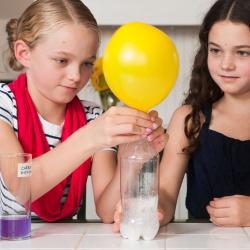Source Institutions
Source Institutions
Add to list Go to activity
Activity link broken? See if it's at the internet archive

In this activity, learners test to see if carbon dioxide is present in the air we breathe in and out by using a detector made from red cabbage. Learners experiment by exposing the detector to air from a balloon filled by breath, a pump, or a carbon dioxide-producing mixture of baking soda and vinegar. Step-by-step instructions are included with photos. Activity guide includes a "What's going on?" explanation and connections to relevant science concept such as the composition of air we breathe, how alveoli in our lungs absorb oxygen and release carbon dioxide, and the negative effects of smoking and air pollution on our lungs.
- 10 to 30 minutes
- 10 to 30 minutes
- Over $20 per group of students
- Ages 8 - adult
- Activity, Experiment/Lab Activity
- English
Quick Guide
Materials List (per group of students)
- Leaf of red cabbage
- 1 L of water
- Blender
- Liquid measuring cup or large container
- Strainer
- 4 large, clear drinking glasses or containers
- Marker
- Masking tape
- 4 drinking straws
- 3 large balloons (about 20-30 cm when inflated)
- Ruler
- Funnel
- 25 ml (5 teaspoons) of baking soda
- 60 ml (1/4 cup) of white vinegar
- Empty soda or water bottle, approximately 500mL
- Bicycle tire or balloon pump
- Newspaper and/or paper towels
- Rubber band (optional)
Subjects
-
Earth and Space Science
-
Earth Structure
- Atmosphere
-
Earth Structure
-
Life Sciences
-
Ecology
- Human Impact
-
Human Body
- Health and Nutrition
- Medicine
- Respiration
-
Ecology
-
Physical Sciences
-
Chemistry
- Acids and Bases
- Chemistry of Life
-
Chemistry
Audience
Learning styles supported:
- Involves teamwork and communication skills
- Involves hands-on or lab activities
Other
This resource is part of:
Access Rights:
- Free access
By:
Source Collection
- DIY Science Apps
Rights:
- , The Regents of the University of California, 2015
Funding Source:
- National Institutes of Health Science Education Partnership Award, 5R25OD010543-02
